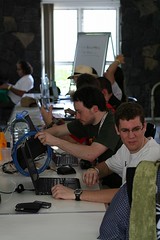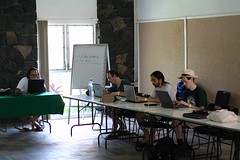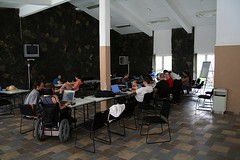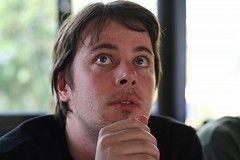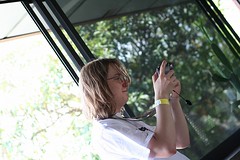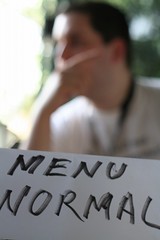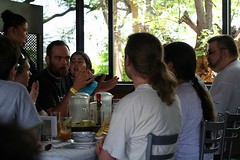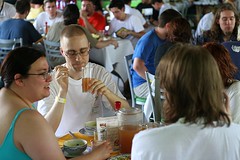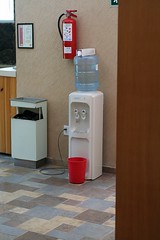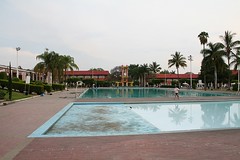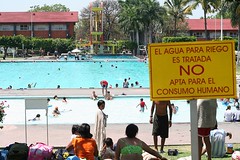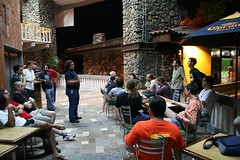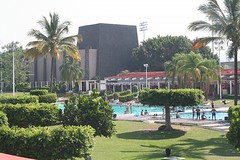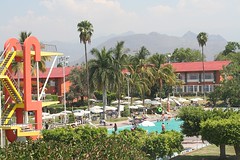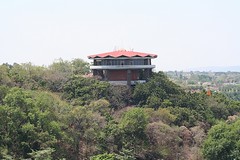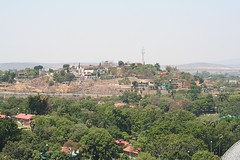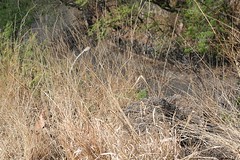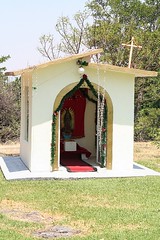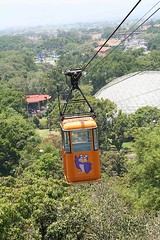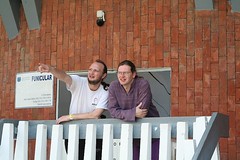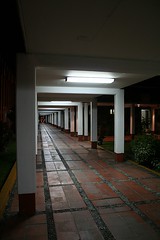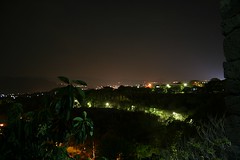Friday - I find out that two of my best friends along with a few coworkers while going to a their company conference in Dallas, USA will be stopping for almost a day in London, tomorrow. I am very happy and agree to show them around the London. Only one of them has been here before.
Saturday, 11:10, Cranfield village, my home: I look at the printout from the Milton Keynes travel authority website stating that a bus from Cranfield to MK will leave Cranfield Crane Way at 11:20, so I leave the house and walk 100 meters to the Crane Way stop. To help me pass the time I start listening to LUGRadio. After around a half an hour I realise that the bus is still not here. I wonder if I did not get the schedule right, so I decide to walk to the Cranfield University (~35 min) to check it on the Internet there.
12:00, halfway between Cranfield village and Cranfield University: I decide to try hitchhiking along the road with absolutely zero luck for the whole half an hour. Now I am at a decision point - I am standing at the junction: one way goes to the university and the other goes to Milton Keynes. I decide to be brave and went on along the road to Milton Keynes still hitchhiking.
12:05, halfway between Cranfield University and North Crawley: I see the Cranfield-Milton Keynes bus go by in the direction of Cranfield, it should come back at some point.
12:20, North Crawley: After a bit of asking around I manage to find the bus stop and in five minutes the bus comes. The ticket from here to MK cost a pound less then from Cranfield. (8 km walked, 2 pounds spent) Happy :)
13:20, Milton Keynes central: I got out of the bus one stop after the shopping centre with all the other passengers, thinking that it was the railway station, but it was actually not - it appears that the bus stops in the shopping centre twice. The railway station is a good walk away.
13:50, Milton Keynes railway station: I planned to go from here to Gatwick airport with a direct coach service that I found on the MK transport authorities web site, however the train station staff had no idea about it. They recommended me to go to Watford Junction as there is a direct line to the Gatwick, so I agree. (11 km walked, 13 pounds spent)
15:30, Watford Junction: The line to Gatwick is closed for repairs, so the staff sold me a ticket to Gatwick via London Euston and London Victoria stations. I also remembered that my friends fly-in at 16:30, so I got a bit worried whether I will make it in time. (11 km walked, 23 pounds spent)
16:00, somewhere in the London tube (aka underground or metro): the ticket did not say the intermediate destinations, so I got a bit lost along the way, but luckily some officers after looking at my ticket bounced me towards the tube and then bounced me around there until I got to the Victoria station.
16:35, London, Victoria Station: My friend call me saying that they have landed. I look at the timetable and see that the next train to Gatwick is in half an hour and will take another half an hour to get there, so I decide to stay in Victoria station and tell my frinds how to find me there. I sit down and continue listening to back episodes of LUGRadio, laughing aloud at some points and attracting a few strange looks.
19:30, London, Victoria Station: My friends arrive. Take a look at the time. They got a bit lost between the airport, the airport hotel and the airport railway station. Fun.
19:30-21:30, London, various places: I take my friends trough one of the traditional sightseeing routes (on foot) managing to take a look (an a picture) on (in order) Westminster Cathedral, Buckingham palace, St. John's Park, Westminster Abbey, Houses of Parliament and the Big Ben, the Eye of London, Golden Jubilee Bridge (which is the best place to take picture of Big Ben now that there are some repairs on the Westminster Bridge), Trafalgar Square and Piccadilly Square. I was just planning to take them by tube to the Tower when they cried for mercy and just asked for a place to eat. So I look at the map and my notes and we choose to go to the main Duke of York up near the King's Cross by tube. (23 km walked, 28 pounds spent)
21:55, London, somewhere near King's Cross: after taking a few "shortcuts" and walking trough completely empty streets for the last 10 minutes we come up to the tiny place called Duke of York only to find it ... crowded to the point where we could barely get into the door. We come up with a backup plan - going back to the Victoria station and looking for some place to eat along the streets there not far away from the station itself. So we go there. (28 km walked, 28 pounds spent)
22:10, London, Victoria Station: after finding another full Duke of York just across the Victoria station entrance and not wanting to go to a pizza house or an American stake house in London, we finally settled on a Scottish Stake House. The manager was Italian and the waitress was Russian, but it did only added to the fun. The food was really nice if one managed to pick a dish without bones in it. The dinner went to 15-20 pounds per person. (29 km walked, 28 pounds spent (on transport))
23:59, London, Victoria Station: after seeing my friends run off to the last train to the airport (last one that their return tickets were valid for), I felt relieved and went to the ticketing office expecting to get home without much trouble now. In reply to my request for a ticket to Bedford or Milton Keynes the ticket officer said "You want to get to Bedford? At midnight?" in a totally unbeliving tone. That made me worry a bit. "You have to go to the King's Cross station and then go to King's Cross Thameslink. You might just get the last train at half past midnight."
00:01, London, Victoria Station: I take a look on the tube map and decide that I just need to take the Central line in any direction and it will take me to King's Cross in no time at all, so I hop into a train going East. After a few stops I discover that trains from the green District line also run along the same tracks that the Central line trains and I had just got on the wrong one. No problem I think - I will just get out at Tower station and get on to the next Central line train. (29 km walked, 31 pound spent (on transport))
00:20, London, Tower station: I get off the train just as announcer says that this train will not go further along the District line and is terminating here instead. I check the timeboard and it says that a Central line train is due in two minutes. The announce goes on to say that due to planned repairs a few lines are closed in some parts as of 20 minutes ago, then he proceeds to read out lines and stations - I stand by the tube map and as I look at it all the lines that go trough King's Cross are getting closed one by one in all directions for at least three to four stops from the King's Cross.
00:25, London, Tower station: Remember about that Central line train that should have been here 3 minutes ago? Well, it is not on the board anymore, actually there is no trains on the board anymore at all. Lots of people on the station are getting nervous.
00:30, London, Tower station: My last train to Bedford is leaving, but I am still stuck in the Tower. Additionally the announcer says that all the lines around the place where I am sitting experience huge delays due to massive electrical discharge problems. Fun. At this point I understand that I will not get anything from the tube and that I will not get out of the London tonight, so I get out of the station and start walking towards the King's Cross. The weather is nice, but a bit chilly.
03:10, London, King's Cross: Hey I am here, where are the trains? The station opens in 5:30. It starts raining and gets colder. Still fun. (50 km walked, 31 pound spent (on transport))
04:30, London, surroundings of King's Cross: I find a 24 hour e-Cafe that is charging 2 pounds for an hour of Internet. At least it is warm. (51 km walked, 31 pound spent (on transport))
05:30, London, King's Cross Thameslink: The station is being opened only to say that due to track repairs no trains are leaving King's Cross Thameslink until 11:30, but that the trains will go to Bedford from West Hampstead and there will be a special bus going there from King's Cross bus stop in a few minutes.
05:40, London, King's Cross bus stop: The rain gets stronger. Around 40 people are standing at the bus station and asking driver of every bus that stops there: "Are you the special bus?" to which drivers shake their heads and leave in a hurry.
05:55, London, King's Cross bus stop: A bus comes that is labeled "The special bus that is replacing the train", everyone gets in - it is free after all. The bus departs along the route of the train stopping along the way, but not opening the doors (because everyone who knows about the bus is already on it).
06:12, West Hampstead: the bus arrives to the station and we see that there was a train to Bedford due at 06:10. As we look at it, the sign changes saying that the train is delayed for a half an hour to 06:40. people swear a bit and cramp into a small waiting room on the platform trying to warm it up by breath. The plan is largely successful. (52 km walked, 45 pounds spent (on transport))
06:40, the train arrives. Happy, sleepy.
08:10, the train arrives to Bedford. Happy, very sleepy. Walking slowly to the bus station. It could be a bit closer to the train station, or at least there could be a fully marked route.
08:55, the bus 159, Bedford - Cranfield is on the route. I am the only passenger. I nod off around the half way and wake up 300 meters before Cranfield Swan stop (which is the stop right after the one near my house, but is right near my friends Dmitry's house). I get off the bus in a hurry. (54 km walked, 48 pounds spent (on transport))
08:56, Cranfield village: I discover that I have just lost my phone (Palm Treo 600). I remember that I was listening to the LUGRadio on it in the train and I think that I remember listening to it on the bus. I run to Dmitry's place and call my number. Nothing is ringing in my pockets, so the phone is gone. I hope it is on the bus and the driver can hear it ring. Adrenaline is the best thing in the morning.
09:06, Cranfield village: the bus 159 goes to the Cranfield University and then comes back to Bedford via the village again, so I am standing in the stop trying to catch it, hoping that I will not have to go all the way to Bedford or London in search for my phone. I am lucky, the bus stops and the driver hand me my phone.
I went back into the Dmitry's house to have a cup of tea, tell him this tale of fun of travelling in UK and watch a movie and got back home around noon.
55 km walked, 48 pounds spent on transport, some more on food, 24 hours of ... Fun ... Fun ... Fun :D
